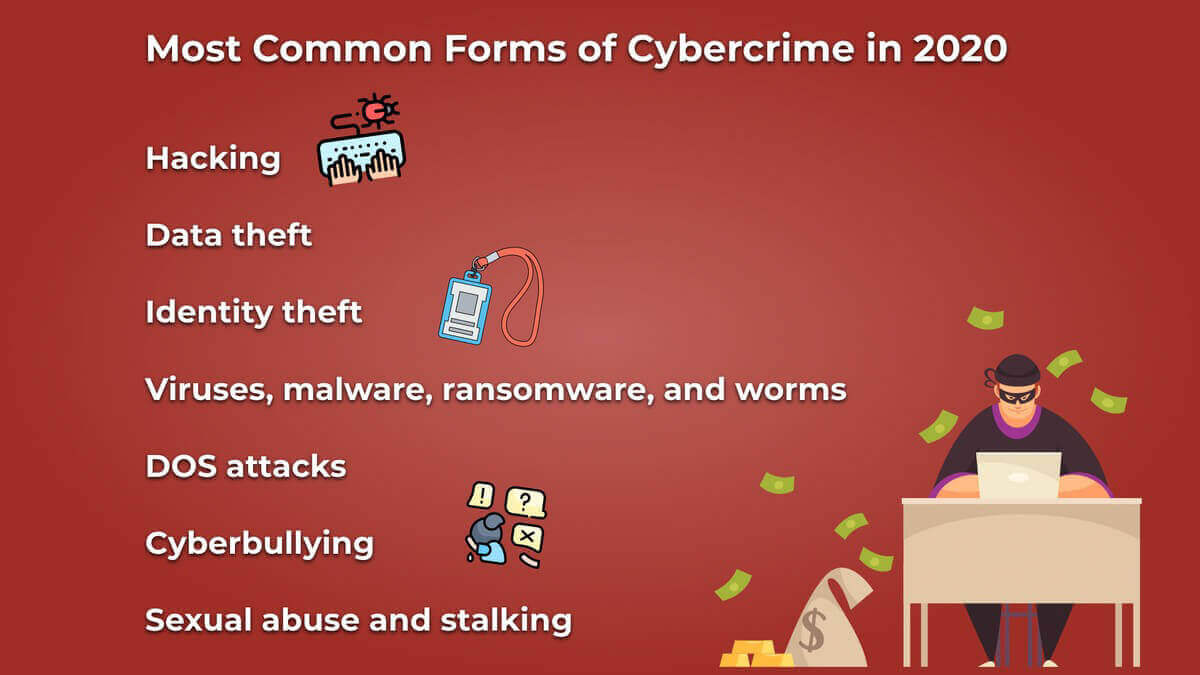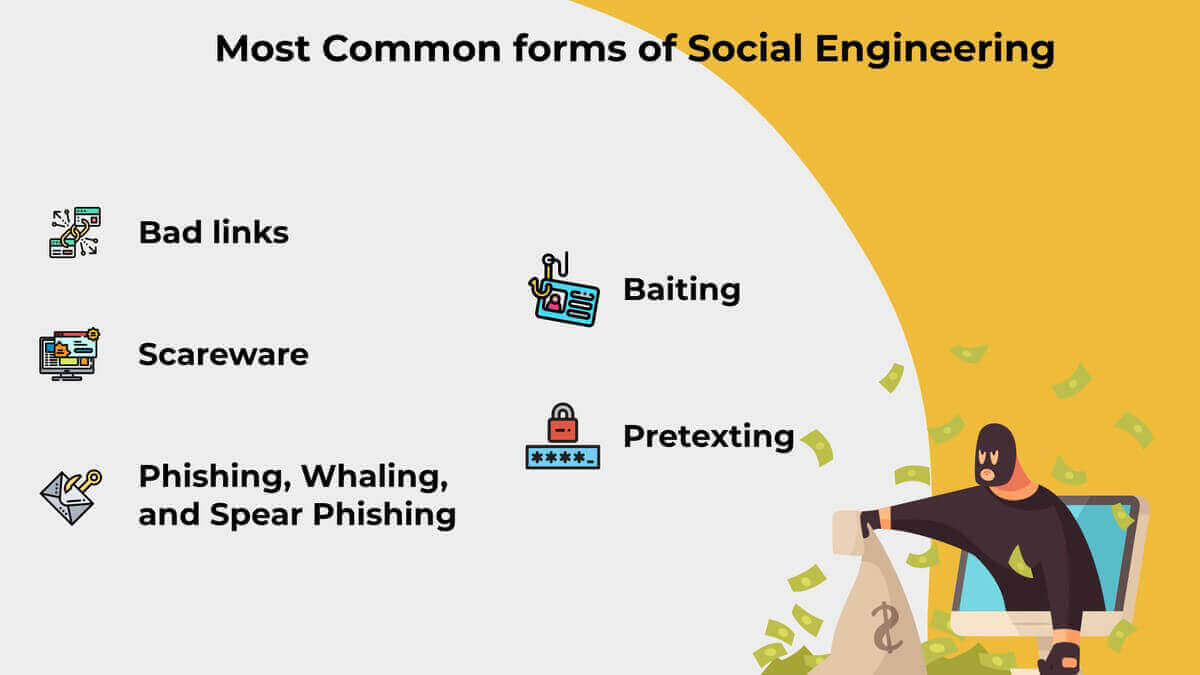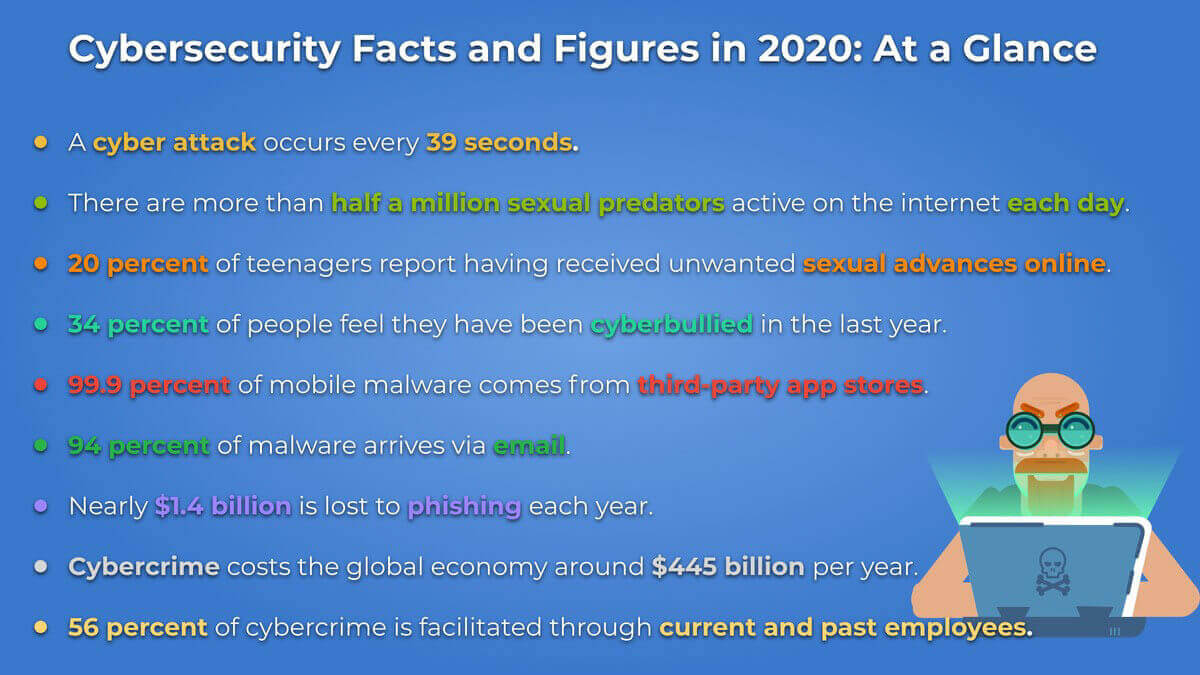Top Cybersecurity Facts You Need To Know
Table of Contents
In our digital world, we are now more connected than ever. While this networking brings tremendous benefits, we need to be realistic about the threats that exist in this new world.
These threats can lead to financial loss or even ruin, but most people are unaware of the full danger cybercrime poses to their peace of mind and their finances.
This guide will show you the many threats in the digital world and how to protect yourself against them. Get all the cybersecurity facts and figures you need to stay safe and keep your info secure when you’re on the web.
Cybercrime: Definition and Examples
Cybercrime is defined as any crime that takes place through a computer. The most common forms of cybercrime are:

Hacking
Hacking is when someone gains unauthorized access to a private system or data set. Once hackers are inside a system, they can do all sorts of damage, such as eliminating or stealing data. They can also rewrite permissions and other code that allows them to do even more damage, or they could even hold the entity they’ve hacked hostage to try and maximize the return on their effort.
Hackers are motivated by different things, but the two biggest drivers are money and fame. Successful hacking can be quite profitable, especially if it gives hackers access to valuable financial information, but fame is another big one. The hacker community is made up of people who are constantly trying to one-up each other, encouraging hackers to do damage even when there is no financial reward for them.
Data Theft
Another significant type of cybercrime is data theft. This is when hackers steal lots of information from the servers they break into. Usually, the data they go after is financial, such as bank account numbers, credit card numbers, social security numbers, account login information, etc.
Data theft is a big deal, and as the world goes more and more digital and we put increasing amounts of information on the web, it’s becoming even more serious. Companies are working hard to keep your data safe, but cybercriminals are always working just as hard to get at it.
Identity Theft
Identity theft occurs when a cybercriminal can get enough of your personal information to impersonate you on the web. The cybercriminal will then usually take out credit cards in your name and use them to make expensive purchases before running far away. Or, they will access your personal bank accounts and steal directly from you.
If you fall victim to identity theft, it can be tough to prove that it wasn’t you who was taking these actions. That’s why it’s so important to remain vigilant and put up good cybersecurity defenses to stay safe.
Viruses, Malware, Ransomware, and Worms
Your computer can become infected with malicious programs that steal information or extract money from you. Ransomware is particularly dangerous because it takes over your entire computer and forces you to pay a large sum of money to get your data back. Depending on what you have saved on your computer, it can be tempting to fall for these threats. Instead, contact the authorities when you have become a victim of ransomware.
Denial-of-Service Attacks
Denial-of-service attacks (DOS attacks) occur when cybercriminals overload a website or server to try to crash it so that they can gain access to it. They usually do this by generating a load of fake traffic that the site can’t handle. This attack shuts everything down, including the site’s defenses, and hackers can then get in and steal whatever it is that they’re after.
Cyberbullying
Cyberbullying is a form of cybercrime that has nothing to do with hacking but is still very much a danger we should be aware of while we’re on the internet. Cyberbullying resembles in-person bullying as an attempt to cause someone mental harm, but cyberbullying takes place online. Online bullying is usually more difficult to detect and can also often be more harmful, mainly because victims of cyberbullying typically suffer in silence.
Child Abuse and Stalking
Because of the anonymity offered by the internet, sexual predators and other deviants use the internet to find their victims. Children are at risk because they are often more naive and willing to talk to strangers, especially if these strangers seem to offer them a way out from a difficult situation at home. But even for adults, online stalking is still a risk. Make sure to be cautious when communicating online with strangers, even if someone claims to know someone you also know.
How Cybercriminals Do Their Work: Social Engineering
In some cases, cybercriminals will launch a broad assault on a network or system, using randomly generated login information repeatedly until they find something that works and grants them access.
However, the success rate for this approach is relatively low, so most hackers turn elsewhere to carry out the final stages of their cybercriminal work; they try to manipulate you to give them access.
This manipulation is known as social engineering and includes the many tactics cybercriminals use to trick you into giving them information. It’s essential for you to know how to recognize social engineering, so you won’t be fooled.

Bad Links
Cybercriminals will try to get you to click on a link that causes a program to download on your computer. These programs can target your specific computer, or provide the hacker with access to your whole network.
These links might be hidden so you don’t know they’re there, but that usually only happens on shadier websites–so be careful where you travel on the web.
You might also get a pop-up that says something like “click here to claim your free prize." Remember, if it’s too good to be true, then it probably is. Always be conservative when it comes to clicking on links.
Scareware
Scareware is one common way cybercriminals try to get you to click on a bad link. This tactic tricks you into thinking that you’ve got a virus on your computer and that you must download an anti-virus software (by clicking on the link provided) to install it on your computer and save all your data.
Don’t fall for this. Trust your existing anti-virus program, and if you don’t have one, then get one from a reputable company and run a scan on your computer.
Phishing, Whaling, and Spear Phishing
Phishing is an attempt by cybercriminals to get you to give them access to either your personal information or your network. Phishing attacks usually come in the form of an email from what looks like a reputable source, such as a friend, someone you know, or an organization or company. They can also come from phone calls, texts, and other notifications to your phone.
The message might include a spoofed design, which means the email was made to look as real as possible. But there is always something off, usually the address from which it was sent. If you look at all email addresses carefully, you will protect yourself against many phishing attacks.
Spear phishing occurs when cybercriminals target specific people. Regular phishing means criminals are simply going after anyone willing to fall for their tricks.
Whaling goes even further by targeting people such as CEOs and other higher-ups, who tend to have more network access.
Baiting
Baiting is old school in that it relies on someone finding a hard copy of the virus or other malicious program the cybercriminal is hoping to install. Criminals will leave a USB drive or some other storage device out in a public space and label it something that seems appealing. They then hope someone will pick it up and install it on their computer so they can steal data.
It sounds like a long shot because it is. However, if you come across any suspicious hardware, report it, and don’t use it.
Pretexting
Pretexting messages try to convince you there’s some pending doom related to one or more of your accounts. For example, you might get a message that says, “your account will expire in 24 hours if you don’t act now." When you log in to the link the message provides, the cybercriminal will steal your login information.
If you get a message like this one, double and triple-check that it’s real before handing over sensitive information. Try making a phone call to the organization behind the message.
Cybersecurity Facts and Figures in 2020
Cyberthreats are becoming more complex and more common. Perhaps you’ve never come across any of these cyberthreats. You still need to be vigilant. Here are the latest stats to show you how common cybercrime has become:

1. A cyberattack occurs every 39 seconds
The University of Maryland did a study in which they lowered the defenses of a set of computers and then monitored how often they were attacked. They found that an attack occurs, on average, every 39 seconds. Your system defenses and antivirus software block most of these, but that’s why it’s so important that you set up the proper defenses.
2. 23 percent of Americans have lost personal or financial information to hackers, or they know someone who has
Almost one out of every four people has suffered from a cyberattack. That’s a pretty substantial number. Considering that identity theft and financial loss can have consequences for years, it’s critical to guard your information.
3. Mobile malware variation has increased by 54 percent in the past few years
With the rapid growth in smartphone use, hackers are increasingly targeting these devices to steal the information they want and your money. They’re getting better at it all the time, creating new types of malware designed to circumvent the defenses we have in place.
It’s crucial to not only establish defenses but continue to update them. Updated software will remain effective against the newest types of malware put out by cybercriminals practically every day.
4. There are more than half a million sexual predators active on the internet each day
If you aren’t convinced that the internet is a hotbed for all sorts of sexual deviants and predators, consider that the FBI estimates there are between 500,000 and 750,000 sexual predators active on the web each day.
Those who have children should be aware of this number.
However, these particular cybercriminals work differently. They usually operate in environments where they can chat with strangers, such as chatrooms and social media, so it’s easier to avoid these creeps.
Simply stay away from these sites or exercise extreme caution and don’t give away any valuable information if you do wind up on them. Make sure your children understand these risks and are practicing safe online habits so that they can stay away from this serious danger.
5. 20 percent of teenagers have received an unwanted sexual advance
20 percent of teens have received a sexual advance they didn’t want online, another statistic that should be pretty scary to anyone with children. This can happen anywhere, particularly on social media and in chatrooms, so either prohibit your kid from using these or, more practically, make sure they are fully aware of the risks and aren’t doing anything that’s putting them in unnecessary danger.
6. 34 percent of people feel they have been cyberbullied in the last year
Just about one-third of people feel they have been cyberbullied in the past 12 months. Of course, cyberbullying doesn’t present the same potential danger as phishing and hacking or contact with sexual predators. Still, people who are repeatedly subjected to it can often suffer long-lasting mental health concerns.
Cyberbullying tends to occur more amongst children and teenagers, but it is most certainly not confined to this age bracket.
If you see cyberbullying occurring somewhere online, speak up and try to stop it. If you yourself are a victim, set up blocks to keep these people away, or stop using whatever platform you are using. Also, monitor your own behavior to make sure you’re not engaging in cyberbullying. What you think of as harmless fun could be doing someone lots of damage.
It’s also important to talk to your children about what cyberbullying is and why it’s bad so that they can learn to recognize when it’s happening either to them or someone with whom they interact on the internet.
7. 99.9 percent of all mobile malware comes from third-party app stores
Mobile malware and mobile malware variation are on the rise. It turns out there’s a pretty easy way to avoid this: only download apps that come from reputable places, such as the Apple App Store and Google Play.
Third-party app stores are not sanctioned and, therefore, not regulated. While people use them to get cheaper or free apps that are similar to the official ones, they are also a hotbed for malicious software.
Stay safe and stick to the approved channels for downloading apps.
8. 94 Percent of malware arrives via email
Nearly all malware arrives by email.
Always double check sender addresses before clicking on anything in an email, make sure your spam filters are working, and don’t click when you get that feeling that something is wrong.
9. Phishing accounts for 40 percent of all social engineering attempts
Forty percent of all social engineering attempts originate as phishing. Understand that your email account is a source of high risk, and survey it carefully. Think before you click!
10. Nearly $1.5 billion is lost to phishing each year
If you’re wondering why cybercriminals use phishing to do their dirty work, consider that their efforts cost us $1.5 billion each year. Due to phishing’s effectiveness, we can expect cybercriminals to continue to use it to take advantage of unsuspecting web users.
11. Forty percent of phishing command-and-control centers are in the United States
Phishing isn’t just a bunch of shadowy hackers based overseas. Just under half of all the world’s phishing attempts are conducted from somewhere inside the United States. Phishing is a global problem, and we must address it as such to improve security around the world.
12. Cybercrime costs the global economy around $445 billion per year
When a cybercriminal succeeds, the person or organization affected must be ready to cover the cost of lost funds, determine what happened, and install new security systems.
For smaller organizations and individuals, this cost isn’t usually tremendous. But for bigger institutions, it can be extreme. Added all together, cybercrime costs the global economy just under half a trillion dollars a year. This astronomical sum shows the impact cybercrime has on our world.
13. $64.2 billion was spent in 2019 on managed security services
Part of the cost to the global economy that companies must assume is that of managed security systems. These are outsourced security efforts whose sole purpose is to keep a company or institution safe from cybercriminals.
Each year, due to the rising number of threats, companies have to spend more and more money. In 2019, that number was $64.2 billion, and we can expect that to go up every year moving forward.
14. Employees bring on 56 percent of cybercrime that harms companies
While companies are spending a small fortune on systems to keep them and their customers safe, the reality is that the biggest threat comes from within. Almost half of all cybercrime is brought on by either past or present employees, sometimes intentionally as a form of vengeance, but usually by accident.
In other words, someone falls for a phishing attempt, which can cost the company big time. The average cost for dealing with a cyberattack is around $1.6 million.
For most companies, this number is too terrifying to think about, and if you work for or run a small business, your fear is justified. Some 60 percent of small and medium companies that suffer a cyberattack are forced to close their doors. Now that’s terrifying.
15. 66 percent of small business still don’t see cybercrime as a likely threat
However, despite these staggering numbers, two-thirds of small business owners still don’t see cybercrime as something likely to occur at their company. The general logic is that smaller companies have less valuable information to steal. Yet they also have much weaker defenses. Hackers are responding by targeting these companies more, so, if you do own a small business or work for one, not acting now can and probably will cost you in the future.
Stay Safe Out There
We face many threats from cybercrime, both as individuals and as members or larger groups and organizations. Underestimating the danger can have catastrophic consequences down the road.
Stay safe by:
- Using strong passwords and changing them frequently
- Not sharing login information with anyone
- Installing anti-virus software on all your devices
- Updating software frequently to make sure you have the latest defenses
- Activating notifications from your bank about financial transactions to ensure nothing bad is going on
- Practicing extreme caution by not clicking on any potentially suspicious links until you’ve had the chance to verify them
- Avoiding talking to strangers online, and don’t give away any personal information to anyone at any time
- Always being suspicious and thinking before you click.
If you practice these habits and have the right tools in place to protect yourself, it’s unlikely you will have a problem. But cybersecurity is a continually changing landscape, and the best defense is constant vigilance.

